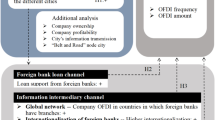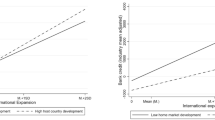Abstract
Despite the rise of interest in emerging market multinationals (EMNEs), the question of whether outward foreign direct investment (FDI) influences their resource acquisition in home countries remains underexplored. Contrary to the prior literature, which contends that EMNEs build outbound linkage through outward FDI so as to leverage outbound resources, this paper, however, focuses on whether outbound linkage influences their inbound resource leverage from home countries as well. Drawing on signaling theory, we propose that outbound linkage to developed countries, developing countries, and tax havens via outward FDI may reflect EMNEs’ different quality and prospects, which in turn influence their inbound leverage of government, financial, and market resources, respectively. Using panel data of 581 Chinese listed firms during the period 2002–2012, we largely verified our hypotheses, thus extending the boundary of the consequences of outward FDI on EMNEs in the signaling theory perspective.
Similar content being viewed by others
References
Ahlstrom, D., Bruton, G., & Yeh, K. 2007. Venture capital in China: Past, present, and future. Asia Pacific Journal of Management, 24(3): 247–268.
Bank of China. 2016. The Bank of China’s Global Corporate Finance (in Chinese). Available at http://www.boc.cn/cbservice/cb13/200905/t20090520_2816499.html.
Barney, J. 1991. Firm resources and sustained competitive advantage. Journal of Management, 17(1): 99–120.
Bergh, D. D., Connelly, B. L., Ketchen, D. J., & Shannon, L. 2014. Signalling theory and equilibrium in strategic management research: An assessment and a research agenda. Journal of Management Studies, 51(8): 1334–1360.
Boisot, M., & Meyer, M. W. 2008. Which way through the open door? Reflections on the internationalization of Chinese firms. Management and Organization Review, 4(3): 349–365.
Buckley, P. J., Clegg, L. J., Cross, A. R., Liu, X., Voss, H., & Zheng, P. 2007. The determinants of Chinese outward foreign direct investment. Journal of International Business Studies, 38(4): 499–518.
Chari, M., & Acikgoz, S. 2016. What drives emerging economy firm acquisitions in tax havens?. Journal of Business Research, 69(2): 664–671.
Child, J., & Marinova, S. 2014. The role of contextual combinations in the globalization of Chinese firms. Management and Organization Review, 10(3): 347–371.
Child, J., & Möllering, G. 2003. Contextual confidence and active trust development in the Chinese business environment. Organization Science, 14(1): 69–80.
Child, R., & Rodrigues, S. B. 2005. The internationalization of Chinese firms: A case for theoretical extension?. Management and Organization Review, 1(3): 381–410.
Connelly, B. L., Certo, S. T., Ireland, R. D., & Reutzel, C. R. 2011. Signaling theory: A review and assessment. Journal of Management, 37(1): 39–67.
Cuervo-Cazurra, A., & Genc, M. 2008. Transforming disadvantages into advantages: Developing-country MNEs in the least developed countries. Journal of International Business Studies, 39(6): 957–979.
Deng, P. 2004. Outward investment by Chinese MNCs: Motivations and implications. Business Horizons, 47(3): 8–16.
Deng, P. 2009. Why do Chinese firms tend to acquire strategic assets in international expansion?. Journal of World Business, 44: 74–84.
Deng, P. 2013. Chinese outward direct investment research: Theoretical integration and recommendations. Management and Organization Review, 9(3): 513–539.
Deng, P., & Yang, M. 2015. Cross-border mergers and acquisitions by emerging market firms: A comparative investigation. International Business Review, 24: 157–172.
Duanmu, J. 2014. State-owned MNCs and host country expropriation risk: The role of home state soft power and economic gunboat diplomacy. Journal of International Business Studies, 45: 1044–1060.
Dunning, J. H. 1998. Location and the multinational enterprise: A neglected factor?. Journal of International Business Studies, 29(1): 45–66.
Ge, W., Kim, J., & Song, B. 2012. Internal governance, legal institutions and bank loan contracting around the world. Journal of Corporate Finance, 8(3): 413–432.
Gu, Q., & Lu, J. W. 2011. Effects of inward investment on outward investment: The venture capital industry worldwide 1985–2007. Journal of International Business Studies, 42: 263–284.
Gulati, R., & Higgins, M. C. 2003. Which ties matter when? The contingent effects of interorganizational partnerships on IPO success. Strategic Management Journal, 24(2): 127–144.
Guler, I., Guillén, M. F., & Macpherson, J. M. 2002. Global competition, institutions and the diffusion of organizational practices: The international spread of ISO 9000 quality certificates. Administrative Science Quarterly, 47(2): 207–232.
Hanlon, M., & Slemrod, J. 2009. What does tax aggressiveness signal? Evidence from stock price reactions to news about tax shelter involvement. Journal of Public Economics, 93: 126–141.
Hoskisson, R., Eden, L., Lau, C. M., & Wright, M. 2000. Strategy in emerging economies. Academy of Management Journal, 43: 249–267.
Hou, M., Liu, H., Fan, P., & Wei, Z. 2016. Does CSR practice pay off in East Asian firms? A meta-analytic investigation. Asia Pacific Journal of Management, 33(1): 195–228.
Hsu, C., Kannan, V., Leong, K., & Tan, K. C. 2006. Supplier selection construct: Instrument development and validation. International Journal of Logistics Management, l7: 213–239.
Jensen, M., & Zajac, E. 2004. Corporate elites and corporate strategy: How demographic preferences and structural position shape the scope of the firm. Strategic Management Journal, 25: 507–524.
Jones, C., & Temouri, Y. 2016. The determinants of tax haven FDI. Journal of World Business, 51: 237–250.
Katayama, S., & Miyagiwa, K. 2009. FDI as a signal of quality. Economics Letters, 103(3): 127–130.
Khanna, T., & Palepu, K. 1997. Why focused strategies may be wrong for emerging markets. Harvard Business Review, 75(4): 41–51.
Kirmani, A., & Rao, A. R. 2000. No pain, no gain: A critical review of the literature on signaling unobservable product quality. Journal of Marketing, 64(2): 66–79.
Le, N. T. B., Venkatesh, S., & Nguyen, T. V. 2006. Getting bank financing: A study of Vietnamese private firms. Asia Pacific Journal of Management, 23(2): 209–227.
Lu, J., Liu, X., Wright, M., & Filatotchev, I. 2014. International experience and FDI location choices of Chinese firms: The moderating effects of home country government support and host country institutions. Journal of International Business Studies, 45: 428–449.
Luo, Y., & Rui, H. 2009. An ambidexterity perspective toward multinational enterprises from emerging economies. Academy of Management Perspectives, 23(4): 49–70.
Luo, Y., & Tung, R. L. 2007. International expansion of emerging market enterprises: A springboard perspective. Journal of International Business Studies, 38: 481–498.
Luo, Y., Xue, Q., & Han, B. 2010. How emerging market governments promote outward FDI: Experience from China. Journal of World Business, 45(1): 68–79.
Makino, S., Lau, C. M., & Yeh, R. S. 2002. Asset-exploitation versus asset-seeking: Implications for location choice of foreign direct investment from newly industrialized economies. Journal of International Business Studies, 31(1): 403–421.
Mathews, J. A. 2002. Competitive advantages of the latecomer firm: A resource-based account of industrial catch-up strategies. Asia Pacific Journal of Management, 19(4): 467–488.
Mathews, J. A. 2006. Dragon multinationals: New players in 21st century globalization. Asia Pacific Journal of Management, 23(1): 5–27.
MOFCOM (Ministry of Commerce of China). 2013. 2012 Statistical bulletin of China’s outward foreign direct investment. Beijing: China Statistics Press.
Morck, R., Yeung, B., & Zhao, M. 2008. Perspectives on China’s outward foreign direct investment. Journal of International Business Studies, 39(3): 337–350.
Narula, R. 2006. Globalization, new ecologies, new zoologies, and the purported death of the eclectic paradigm. Asia Pacific Journal of Management, 23(2): 143–151.
Nee, V., & Opper, S. 2012. Capitalism from below: Markets and institutional change in China. Cambridge: Harvard University Press.
Peng, M. W. 2003. Institutional transitions and strategic choices. Academy of Management Review, 28(2): 275–296.
Peng, M. W., & Parente, R. C. 2012. Institution-based weaknesses behind emerging multinationals. Revista de Administração de Empresas, 52(3): 360–364.
Ramaswamy, K., Li, M., & Petitt, B. S. P. 2004. Who drives unrelated diversification? A study of Indian manufacturing firms. Asia Pacific Journal of Management, 21(4): 403–423.
Reuer, J. J., & Ragozzino, R. 2014. Signals and international alliance formation: The roles of affiliations and international activities. Journal of International Business Studies, 45: 321–337.
Rugman, A. M., & Li, J. 2007. Will China’s multinationals succeed globally or regionally?. European Management Journal, 25(5): 333–343.
Spence, M. 1973. Job market signaling. Quarterly Journal of Economics, 355–374.
Stevens, C. E., Makariusb, E. E., & Mukherjee, D. 2015. It takes two to tango: Signaling behavioral intent in service multinationals’ foreign entry strategies. Journal of International Management, 21: 235–248.
Sun, S. L., Peng, M. W., Ren, B., & Yan, D. 2012. A comparative ownership advantage framework for cross-border M&As: The rise of Chinese and Indian MNEs. Journal of World Business, 47: 4–16.
Taylor, G., Richardson, G., & Taplin, R. 2015. Determinants of tax haven utilization: Evidence from Australian firms. Accounting and Finance, 55: 545–574.
Thitea, M., Wilkinsonb, A., Budhwarc, P., & Mathews, J. A. 2016. Internationalization of emerging Indian multinationals: Linkage, leverage and learning (LLL) perspective. International Business Review, 25(1): 435–443.
Tsang, E. W. K. 2001. Annual report disclosure and corporate legitimacy management: A study of Singapore companies’ responses to the government’s call for venturing abroad. Asia Pacific Journal of Management, 18(1): 27–43.
van Agtmael, A. 2007. The emerging markets century: How a new breed of world class companies is overtaking the world. London: Simon & Schuster.
Wright, M., Filatotchev, I., Hoskisson, R. E., & Peng, M. W. 2005. Strategy research in emerging economies: Challenging the conventional wisdom. Journal of Management Studies, 42: 1–33.
Xia, J., Ma, X., Lu, J. W., & Yiu, D. W. 2014. Outward foreign direct investment by emerging market firms: A resource dependence logic. Strategic Management Journal, 35(9): 1343–1363.
Yamakawa, Y., Peng, M. W., & Deeds, D. L. 2008. What drives new ventures to internationalize from emerging to developed economies?. Entrepreneurship: Theory and Practice, 32(1): 59–82.
Zeng, S. X., Xu, X. D., Yin, H. T., & Tam, C. M. 2012. Factors that drive Chinese listed companies in voluntary disclosure of environmental information. Journal of Business Ethics, 109: 309–321.
Zhang, Y., & Wiersema, M. F. 2009. Stock market reaction to CEO certification: The signaling role of CEO background. Strategic Management Journal, 30: 693–710.
Acknowledgements
We thank the guest-editorial team and two reviewers of the Special Issue on “A Decade of Dragon MNEs,” as well as the editor and the reviewer of this issue for their insightful and constructive comments. This research is partially supported by National Natural Science Founding of China (No. 71072071) and Monte Ahuja Endowment Fund for the Monte Ahuja Endowed Chair of Global Business at Cleveland State University.
Author information
Authors and Affiliations
Corresponding author
Rights and permissions
About this article
Cite this article
Yan, H., Wang, J. & Deng, P. Outbound linkage and inbound leverage for emerging multinationals: A signaling theory perspective. Asia Pac J Manag 35, 347–372 (2018). https://doi.org/10.1007/s10490-017-9554-8
Published:
Issue Date:
DOI: https://doi.org/10.1007/s10490-017-9554-8




